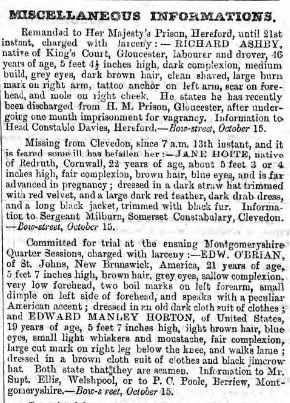The following news release is from Matthew Deighton, with Ancestry.com:
CRIME AND PUNISHMENT: HISTORIC NOTICES OF WANTED CRIMINALS GO ONLINE
More than 90 years of Police Gazette records published online by Ancestry♣ Police Gazettes reveal fascinating information on suspected wanted criminals, crimes committed and missing persons
♣ A suspect in the Whitechapel Murders and infamous Sheffield murderer Charles Peace appear in the records
♣ Entries reveal child murders committed by desperate single mothers who were ostracised from societyMore than 100,000 records and images from Police Gazettes, revealing details of wanted suspected criminals, offenders in custody and missing persons have been published online by Ancestry, the world’s largest family history resource.
The UK, Police Gazettes, 1812-1902, 1921-1927 collection, sourced from Luminary Trading Limited and Lastchancetoread, contains copies of the “Police Gazette”, or “Hue and Cry”. The publication was used for communication between members of the police force across the United Kingdom – much like the National Crime Agency’s most wanted list today.
Searchable by name, age, type, date and location of crime, these records contain vital information and fascinating detail for anybody looking to find out more about either an historic offender or indeed a victim of crime in their family tree. The records can even give a glimpse at the faces of wanted suspected criminals through police sketches issued alongside requests from information.
Several interesting characters feature in the records, including:♣ Charles Peace – Maimed in an industrial incident as a child, murderer Peace appears in the records in 1876 in an appeal for information about his location on several occasions. He’s described as ‘thin and slightly built’, with ‘grey (nearly white) hair, beard and long whiskers’. The record goes on to give details of his trade – a picture-frame maker, with a history of burglary. He murdered a policeman and a neighbour, but managed to stay on the run until he was arrested for burglary in London, and eventually faced the death penalty
♣ Michael Ostrog – Ostrog, one of the suspects in the Whitechapel Murders that made Jack the Ripper famous, was charged with larceny, but failed to report after he was released from Surrey County Lunatic Asylum in 1888. The record lists several of his aliases: Bertrand Ashley, Claude Clayton and Dr. Grant, and describes him as ‘’a dangerous man’, who had moles on his shoulder and neck, as well as ‘corporal punishment marks’. An accompanying sketch of a bearded Ostrog is an example the police tried to identify criminals on the run.
Ostrog was not the only man in the Police Gazettes to use aliases, with one in ten (9%) of all entries featuring a pseudonym, perhaps unsurprising given that most criminals attempt to shield their identity from the authorities.
The records also include a number of reports featuring murdered new-born babies, which illustrates the issues attached to illegitimate children in the 19th Century. The Bastardy Clause in the New Poor Law of 1834 made all illegitimate children solely the responsibility of their mother until the age of 16, which left mothers, often estranged from their families, with limited choices. In desperation, many mothers resorted to infanticide to protect themselves. Many of the mothers were never identified, with the police often seeking more information on the crime. Some examples from the records include:
♣ ‘Ann Yates’ – Murdered her daughter and threw the body into a well in Midsomer Norton, Somerset, in 1875 after being forced to live in the Shepton-Mallet Union Workhouse when she was unable to provide for her illegitimate offspring. The police believed the ‘good-looking’ 24-year old had fled to Cardiff to start a new life
♣ ‘Two women’ – In 1894, the body of a newly-born male child was found in the Leeds and Liverpool Canal at Hoghton, tied up in a white coarse apron. The police sought two women who were observed on the canal bank in Blackburn when a splash was heard, ‘caused by one of the women throwing something into the water’. The younger woman, who ‘appeared to be ill’, was leaning on the arm of an older woman who was ‘tall and stout’
Ancestry’s Senior Content Manager Miriam Silverman comments: “This collection provides rare insight into crime and punishment in the 19th Century as well as helping us to better understand how the British police force worked shortly after it was introduced.”
“Whether you’re locating the black sheep in your family tree, discovering more about an ancestor who was the victim of crime or even unearthing some infamous criminals, these records can help reveal the details.”
To search the UK, Police Gazettes, 1812-1902, 1921-1927 collection for free, and more than 16 billion other historical records worldwide, visit www.ancestry.co.uk.
ABOUT ANCESTRY
Ancestry is the world’s largest online family history resource with more than 2 million paying subscribers across all its websites. More than 16 billion records have been added, and users have created more than 70 million family trees to the core Ancestry websites, including its flagship site www.ancestry.com and its affiliated international websites.
Ancestry.co.uk contains more than one billion records in collections including the most comprehensive online set of England, Wales and Scotland Censuses from 1841 to 1911, the fully searchable England and Wales Birth, Marriage and Death Indexes, the World War One British Army Service and Pension records, UK Parish Records and the British Phone Books.
Ancestry operates a suite of online family history brands, including Archives.com, Fold3.com, Newspapers.com, and offers the AncestryDNA product, sold by its subsidiary, Ancestry International DNA, LLC, all of which are designed to empower people to discover, preserve and share their family history.
